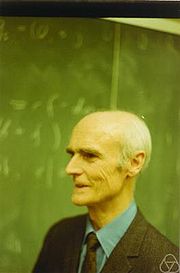H. S. M. Coxeter
- H. S. M. Coxeter
-
H.S.M. Coxeter
Harold Scott MacDonald «Donald» Coxeter (9 février 1907, Londres - 31 mars 2003, Toronto, Canada) est un mathématicien britannique. Il est considéré comme un des grands géomètres du XXe siècle. Une de ses idées originales fut de définir une conique comme une courbe auto-duale. Il s'est fait connaître par son travail sur les polytopes réguliers et la géométrie en dimension supérieure. Il a rencontré M. C. Escher et son œuvre géométrique a été une source importante d'inspiration pour ce dernier. Il a aussi inspiré certaines des innovations de Buckminster Fuller.
Biographie
Il a étudié la philosophie des mathématiques sous la direction de Ludwig Wittgenstein au Trinity College à Cambridge. Il est resté quelque temps à Cambridge, puis a poursuivi ses études à l'Université de Princeton.
En 1936, il enseigne à l'Université de Toronto, où il devient professeur en 1948. Il y a travaillé pendant 60 ans et a publié douze livres.
Honneurs
Au cours de sa carrière, il a reçu plusieurs doctorats honorifiques de différentes universités.
Bibliographie
- (en) The Real Projective Plane (1955)
- (en) Introduction to Geometry (1961)
- (en) Regular Polytopes (1973)
- (en) Regular Complex Polytopes
- (en) Non-Euclidean Geometry (1965)
- (en) Geometry Revisited (avec S. L. Greitzer, 1967) ((fr) Redécouvrons la géométrie. Éditions Jacques Gabay, Paris, 1997. ISBN 2-87647-134-5)
- (en) Projective Geometry (2e ed, 1974)
- (en) The Beauty of Geometry: Twelve Essays
- (en) The Fifty-Nine Icosahedra (avec P. Du Val, H. T. Flather, J. F. Petrie)
- (en) Mathematical Recreations and Essays (avec W. W. Rouse Ball)
Voir aussi
Lien externe
 Portail des mathématiques
Portail des mathématiques
Catégories : Mathématicien canadien | Membre de l'ordre du Canada | Membre de la Société royale du Canada | Naissance en 1907 | Décès en 2003 | Membre de la Royal Society | Ancien étudiant de Trinity College (Cambridge)
Wikimedia Foundation.
2010.
Contenu soumis à la licence CC-BY-SA. Source : Article H. S. M. Coxeter de Wikipédia en français (auteurs)
Regardez d'autres dictionnaires:
Coxeter group — In mathematics, a Coxeter group, named after H.S.M. Coxeter, is an abstract group that admits a formal description in terms of mirror symmetries. Indeed, the finite Coxeter groups are precisely the finite Euclidean reflection groups; the symmetry … Wikipedia
Coxeter–Dynkin diagram — See also: Dynkin diagram Coxeter Dynkin diagrams for the fundamental finite Coxeter groups … Wikipedia
Coxeter element — Not to be confused with Longest element of a Coxeter group. In mathematics, the Coxeter number h is the order of a Coxeter element of an irreducible Coxeter group, hence also of a root system or its Weyl group. It is named after H.S.M.… … Wikipedia
Coxeter — Harold Coxeter, 1970 Harold Scott MacDonald Coxeter (* 9. Februar 1907 in London; † 31. März 2003 in Toronto) war ein britisch kanadischer Mathematiker. Sein Arbeitsgebiet war die Geometrie, unter anderem beschäftigte er sich mit regulären… … Deutsch Wikipedia
Coxeter graph — This article is about the 3 regular graph. For the graph associated with a Coxeter group, see Coxeter diagram. Coxeter graph The Coxeter graph Vertices 28 Edges 42 … Wikipedia
Coxeter number — In mathematics, the Coxeter number h is the order of a Coxeter element of an irreducible root system, Weyl group, or Coxeter group. DefinitionsThere are many different ways to define the Coxeter number h of an irreducible root system.*The Coxeter … Wikipedia
Coxeter notation — In geometry, Coxeter notation is a system of classifying symmetry groups, describing the angles between with fundamental reflections of a Coxeter group. It uses a bracketed notation, with modifiers to indicate certain subgroups. The notation is… … Wikipedia
Coxeter-Dynkin diagram — In geometry, a Coxeter Dynkin diagram is a graph with labelled edges. It represents the spatial relations between a collection of mirrors (or reflecting hyperplanes), and describes a kaleidoscopic construction.The diagram represents a Coxeter… … Wikipedia
Coxeter–Todd lattice — In mathematics, the Coxeter–Todd lattice K12, discovered by Coxeter and Todd (1953), is a the 12 dimensional even integral lattice of discriminant 36 with no norm 2 vectors. It is the sublattice of the Leech lattice fixed by a certain… … Wikipedia
Coxeter — H.S.M. Coxeter Harold Coxeter, 1970 Harold Scott MacDonald «Donald» Coxeter (9 février 1907, Londres 31 mars 2003, Toronto, Canada) est un mathématicien britannique … Wikipédia en Français
Coxeter, H.S.M. — ▪ British mathematician in full Harold Scott MacDonald Coxeter born Feb. 9, 1907, London, Eng. died March 31, 2003, Toronto, Can. British born Canadian geometer, who was a leader in the understanding of non Euclidean geometries (non… … Universalium

